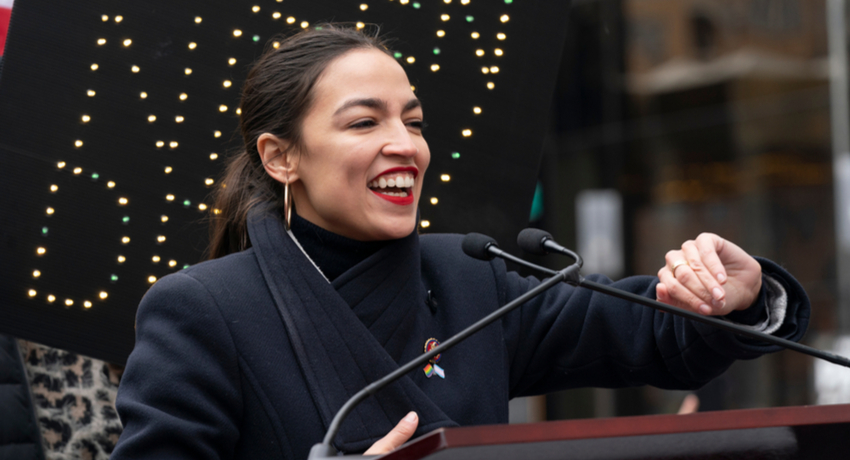With all the recent brouhaha around the video of Alexandria Ocasio-Cortez dancing in her college days, one could be forgiven for thinking that we’ve woken up in the 1984 box office hit Footloose. Only in 2019 the protagonist is not a white male teenager from out of town but rather a young woman with Puerto Rican ancestry, who, at age 29, recently became the youngest serving member of the US Congress.
“Wait till they find out Congresswomen dance too!”
On the day of Ocasio-Cortez’s swearing in, a social media user posted a video of the politician, often referred to by the nickname AOC, dancing on a rooftop and captioned the clip with derogatory comments about her intellect. Rather than cowing to the criticism, the Congresswoman responded by tweeting a short video of her dancing her way into her congressional office, with the caption “I hear the GOP thinks women dancing are scandalous. Wait till they find out Congresswomen dance too!”
As of 9 January the tweet had received over 780,000 likes. While the anonymous poster, whose profile has since been deleted, evidently intended the initial video to be an attack on AOC, the video, taken from a longer video of her and other young people dancing in their college days, has instead resulted in support from fans and celebrities around the globe.
I hear the GOP thinks women dancing are scandalous.
Wait till they find out Congresswomen dance too! 💃🏽
Have a great weekend everyone 🙂 pic.twitter.com/9y6ALOw4F6
— Alexandria Ocasio-Cortez (@AOC) January 4, 2019
This is not the first time that a media stir has arisen following a female politician dancing in public. In a quite different context, last year Theresa May’s dancing was the focus of multiple media reports when, during a trade trip to Africa in August she danced along with students in Cape Town and with Scouts in Nairobi. Appearing to embrace the attention, May was then recorded dancing onto the stage of the Tory party conference this past October.
But what can all this tell us about politics and prospects for social change in 2019?
As we explore in Dancing Across the Dissonance, the book we’re currently writing for Manchester University Press, dance can help us understand social and political change, both through the embodied act of dancing constituting a political expression, and through the ways dance functions as a metaphor for political dialogue.
In our research, we consider the work of an NGO and its participants deploying dance for peacebuilding through case studies across three contexts—Colombia, the Philippines, and the United States. We explore how dance, as an aesthetic, embodied medium, can embrace emotions, support relationships across difference and supplement and sustain verbal linguistic forms of dialogue.
The practice of dance can help nurture embodied empathy and facilitate communication, connection, and understanding across difference
Focusing on young people as peer leaders, we learned that the practice of dance can help nurture embodied empathy and facilitate communication, connection and understanding across difference, and across diverse local and global actors and contexts.
In fact, this capacity of dance, along with the ability of creativity to foster political movements, may well be why AOC’s dancing resonated so far and wide, inspiring a variety of mash-ups and a Twitter account titled ‘AOC Dances to Every Song’ that has already attracted over 29,000 followers.
It’s important to note that the political use of dance carries risks
At the same time, it’s important to note that the political use of dance carries risks, including the capacity for reinforcing stereotypes or being mobilized to detract from important discussions. In our research, as in the cases of Ocasio-Cortez and May, it is clear that dance often prompts explorations around a range of identity factors, including age, gender, ethnicity, and culture.
The similarities and differences in the case of the two dancing politicians highlight this. Both AOC and May are women and elected officials who deployed dance during key political moments. Both used dance as a means of communication and a form of power, but they did so from different positions, in different ways, for different reasons, and to different responses.
While May danced as an older, white woman from the UK dancing with younger African students, Ocasio-Cortez danced along with a diverse group of her peers and later on her own. May was purposefully dancing in public as a politician unlike AOC, who was ‘outed’ for dancing in the past, but then responded by dancing in her current role as a politician.
As a young, progressive minority woman, AOC drew attention from conservative commentators attempting to shame and diminish her for moving her body in order to bolster their arguments against her suitability to lead. In her defiant and embodied response, AOC claimed her right to take up space, to be seen, and instead of hiding or being shamed, she resisted political narratives critical of her movement through dancing more and re-steering the message in her favour.
In contrast, May, herself a conservative politician advocating for austerity measures and furthering national politics, might actually hope for criticisms of her moving body to distract from how her policy platforms cause harm to other women and people of colour, and counteract the claims for being ‘out of step’ with the needs of the young people.
“Hard times require furious dancing”
Overall, both cases pose opportunities and challenges for those seeking to invoke dance to political ends. At the same time, our research unveiled important contributions dance can make as a means of self-care for people in politically challenging situations, including those seeking to make social change in contexts affected by conflict.
In short, as the lauded American writer Alice Walker writes, “Hard times require furious dancing.” So roll on 2019, and as for those ready to see some positive social change, get to stepping.
Alexandria Ocasio-Cortez and other students from Boston University perform a dance from The Breakfast Club – full video




